
Optimizing a blog for search engines is very different from eCommerce websites. Blogs are more casual in tone and focus on providing information about current events or topics that interest readers. They're also less formal than other types of web content, so there's no need to use perfect grammar or formatting standards since anyone can post something at any time. By contrast, an online store will likely have clear guidelines surrounding what constitutes "quality" product images/videos, etc., which makes sales and more customers easier.
What Are SEO Differences in eCommerce?
There are some SEO differences between traditional blogging practices & eCommerce sites. We give for a more effective way to understand.
1. Meta tags:
While less important for eCommerce, you can still use them! But beware of keywords in particular. Search engines have improved at examining the context, so it'll look very unprofessional if you stuff your meta tag with keywords. As a result, it may even rank lower than sites.
2. Image optimization:
You can't just upload an image and expect your eCommerce to get tons of traffic, not when thousands of other eCommerce sites are out there. This means you need your pictures to be in the best shape possible! This means a bigger file size, so I recommend image editing software like Photoshop or a free alternative.
3. Internal linking:
This is one of my favorite SEO practices, and it's easy to implement on eCommerce sites! If you have an internal page about a particular product, link to it from the product page, and link back to the product page from that post. If you have a category on your site for each product, link to each item within the post or in an "up-sell" or "related posts" section!
4. Write for humans:
You should write for human interaction. If you write search engines, this is not impressive for people. Full of keywords contents can't be meaningful generally(as we know)—for example, clickbait. If you want to reach out to more people, you should write for humans, not clickbait.
5. Guest blogs:
This is one of the best ways to gain exposure and increase your search engine optimization. In addition, guest blogging is a great way to build relationships with other bloggers and webmasters. You can even link back (or forward) to your eCommerce site!
6. Social media:
I'm sure you've heard before that social media isn't an SEO strategy, but it can be if done right. You should share your blog posts on social media platforms like Facebook, Twitter, LinkedIn, Pinterest, and Google+ to gain exposure for your eCommerce site!
7. Don’t buy links:
This is not recommended by any means (and may even get you into trouble with search engines). Still, some people buy links to gain better positioning on search engines. But, again, I don't recommend this unless you know what you're doing, and be aware that it might backfire!
What Are SEO Tips For eCommerce?
Every digital marketer worth their salt will tell you that content is king and it's the backbone of any successful SEO strategy, but does excellent content really equate to profitable conversions?
It can if your eCommerce site has a strong customer focus. Yes, we know this is only common sense, but there's more to it than simply putting the customer first. You see, most eCommerce sites tend to be inward-focused and think about their own needs rather than those of their customers. Unfortunately, this means that they aren't focusing on what matters — converting visitors into paying customers — which is why we're going to debunk the most significant conversion rate myths out there right here and now.
Basically, I'm trying to say that content is king for SEO. Period. Other factors, such as backlinks, don't even come close in comparison. Investing your time into writing detailed blogs on relevant topics is the way to go, rather than wasting time trying to force links or "trick" Google.
Where Should I start If I'm New to SEO in the eCommerce World?
I suggest your SEO course. If you want to learn SEO quickly and correctly, it’s the best way to learn from experts. IIENSTITU has an SEO course, and you can learn from an expert. The instructor is the best digital marketer ever and is experienced in many sectors. So we handle the other paths. If you are new, this is a little bit complicated. But don’t worry, you can learn step by step in the course;
1) Register for an Adwords account. This is free and will allow you to see how much traffic specific keywords receive daily. Google makes its money by selling ads. Giving you some insight into how competitive a keyword is and what you should aim for. You can also see how much competition there is for a given term if it's worth using the term as an SEO phrase, etc.
2) Conduct research on your competitors to learn more about their strategies and plans. Look up sites that sell similar products like yours and see what they do differently and how you might exploit their weaknesses. Try googling "[product] + [competitor]" or "[your product] + [marketplace]" - for example, if I was selling coffee mugs, I might look up "coffee mug" on Google and compare the results with other online stores.
3) Think about what you can do for customers. Of course, the quality of the product is the most essential factor. Still, suppose your prices are higher than your competitors, or you have a terrible return policy or have horrible shipping times. In that case, it will hurt your bottom line.
4) Look at analytics from other websites to see what kinds of pages people visit before they buy. These pages might be essential to optimize for, and additional pages you could build with this in mind.
5) Pick a few keywords to target (three is good ... more than five will make it look spam) and start writing for those terms. You can work your way up to more money-making keywords later if your site starts to take off.
6) Create a few pages and test them - the best way to see how good your content is by indexing it with Google's "test my site" tool.
7) If you still have time after working on keywords, spend some time optimizing for local/regional searches and international ones - getting a few dollars from customers who will see your site in their native language is excellent.
8) Spend some time looking for good, fresh backlinks; eventually, you might be able to use this as attribution for your website (this is a more advanced topic).
9) Spend some time looking at competitor behavior - this will help inspire ideas that may not have occurred to you before. You can find this information by googling "[competitor] + [keyword]" or just browsing their site for new features that you might implement.
Don't worry too much about off-site SEO like link building and directory submissions at first. These things take a while to take hold, and they will naturally happen as your site becomes more popular. So just focus on on-site optimization for now!
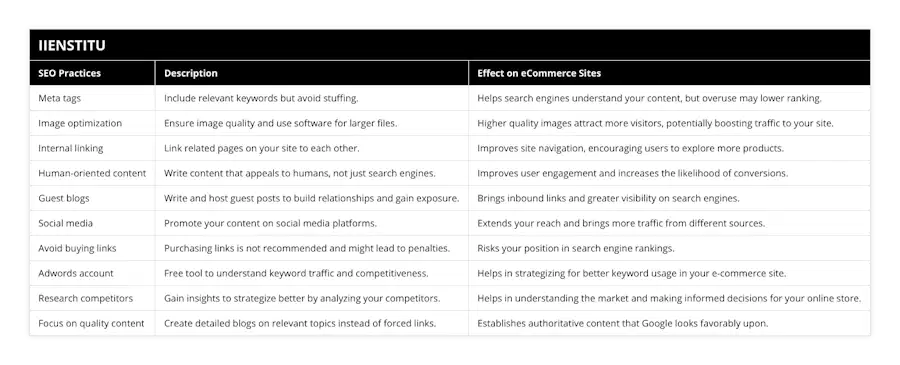
Frequently Asked Questions
How is ecommerce SEO different from traditional SEO practices?
Ecommerce SEO vs. Traditional SEO: Core Differences
Ecommerce SEO primarily focuses on optimizing online stores for better search engine visibility and user experience. In contrast, traditional SEO concerns businesses or organizations with any type of website. There are some key differences between the two practices.
Keyword Strategies
An effective ecommerce SEO strategy revolves around product-specific keywords, including product names, SKU numbers, and brand names. This differs from traditional SEO, which may focus on informational keywords related to the company's niche or industry.
Site Structure and Navigation
Ecommerce websites require a user-friendly and logical site structure to guide visitors through their shopping journey. This is essential for both online store performance and SEO. Traditional SEO also emphasizes site structure, but it generally concentrates on content organization and internal linking, rather than emphasizing the buying process.
Product Descriptions and Content
Unique and engaging product descriptions are a crucial component of ecommerce SEO. They should effectively communicate the benefits and features of products or services, while incorporating strategic keywords. Traditional SEO often focuses on creating informative content, such as blog posts, articles, and whitepapers, targeted toward a specific audience.
User Reviews and Testimonials
For ecommerce SEO, incorporating product reviews and ratings is essential. Positive reviews and testimonials not only influence users' purchasing decisions but also contribute to the site's search engine ranking. Traditional SEO does not prioritize user-generated content as strongly.
Technical Implementation
Ecommerce websites typically operate on more complex platforms, involving product databases, secure transaction processing, and API integrations. Thus, ecommerce SEO demands a higher level of technical proficiency in understanding and resolving issues, such as duplicate content or slow page load times, compared to traditional SEO.
Conclusion
In summary, ecommerce SEO diverges from traditional SEO in several key aspects, including keyword research, site structure, content creation, user-generated content, and technical implementation. While there is some overlap between the two practices, understanding the specific requirements and challenges of ecommerce SEO is essential for online retailers to succeed in today's competitive marketplace.
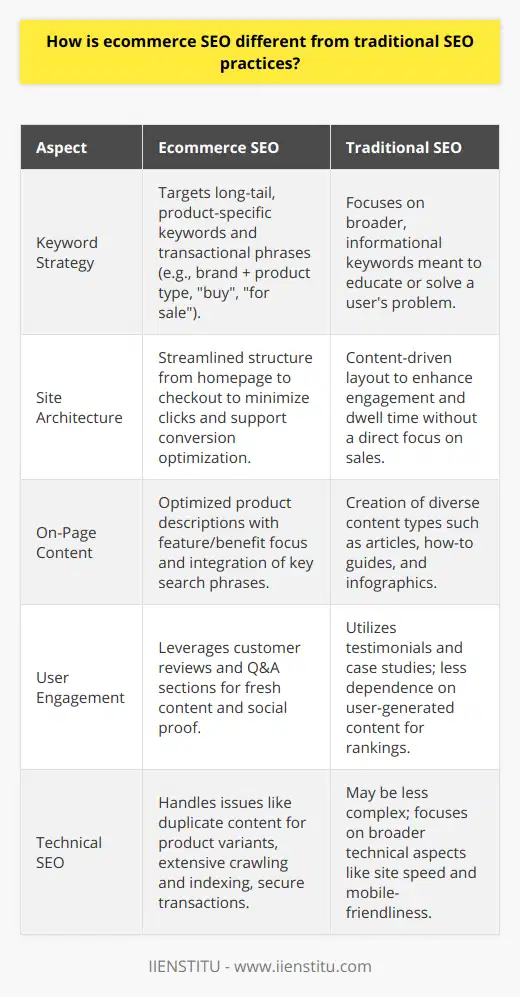
In what ways does SEO play a crucial role in the success of an e-commerce business?
Impact on Online Visibility
SEO plays a crucial role in the success of an e-commerce business primarily by improving its online visibility. Websites with search engine optimized content tend to rank higher on search engine results pages (SERPs), attracting more potential customers. The increased visibility to customers not only enhances brand awareness but also positions the business as an authority in its niche.
Conversion Rates
Another way SEO contributes to e-commerce success is by improving conversion rates. Optimizing an e-commerce website for search engines involves making it more user-friendly and easy to navigate. As a result, potential customers can quickly find the desired products or services, leading to an increased likelihood of completing a transaction. Moreover, incorporating relevant keywords into the content helps ensure that the traffic generated is from users actively searching for the offered products or services.
Decreased Marketing Costs
SEO is a cost-effective marketing strategy for e-commerce businesses, especially compared to traditional forms of advertising. By focusing on organic search traffic, businesses can reduce their dependence on costly paid advertising campaigns. A well-executed SEO strategy attracts high-quality traffic and a more sustainable customer base, resulting in a lower customer acquisition cost in the long run.
Competitive Advantage
Lastly, SEO provides a significant competitive advantage to e-commerce businesses. Companies that dedicate resources to developing and maintaining a robust SEO strategy continually outperform competitors who neglect this essential aspect of digital marketing. In the increasingly competitive online marketplace, businesses that prioritize SEO are more likely to succeed and maintain a sustainable, loyal customer base.
In conclusion, SEO is of paramount importance for e-commerce businesses, as it influences online visibility, conversion rates, marketing costs, and competitive advantage. By investing in this critical aspect of digital marketing, companies will see tangible results, ensuring long-term success in the ever-evolving online marketplace.
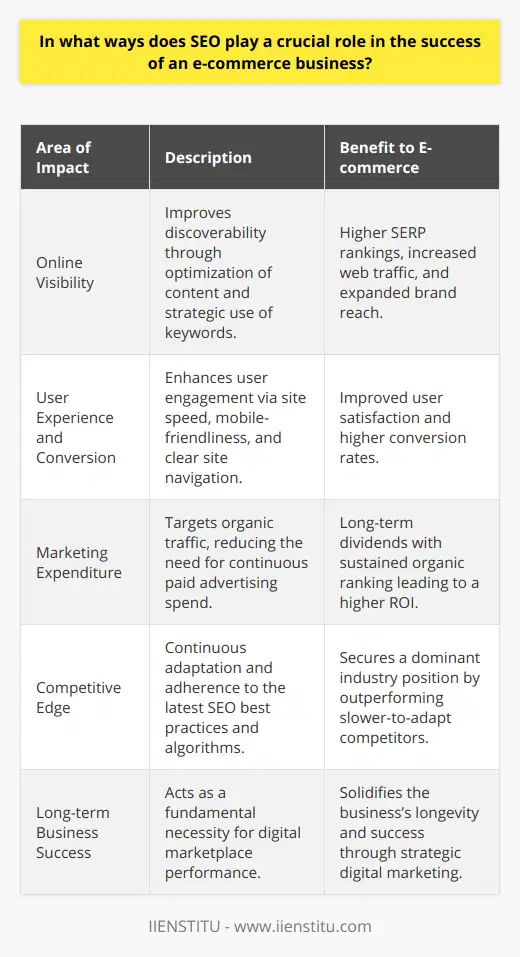
What are the key factors to consider while optimizing the SEO strategy for an e-commerce platform?
Understanding Consumer Behavior
The foremost factor to consider while optimizing SEO strategy for an e-commerce platform involves understanding consumer behavior. Customers' search patterns, preferences, and demographics play a significant role in determining the appropriate keywords and content for attracting traffic and driving conversions.
Website Structure and Navigation
A well-structured website ensures smooth navigation for users, which subsequently leads to an enhanced user experience. Increased engagement factors, such as reduced bounce rates and longer session durations, signal search engines that the website is relevant and valuable, boosting its ranking in search results.
Quality Content
Creating high-quality, original content is crucial for search engines to view the e-commerce platform as a valuable and credible source. Informative, relevant, and engaging content with appropriate keywords, not only enhances the user experience but also facilitates higher search engine rankings.
Keywords and Competitor Analysis
Researching keywords and conducting competitor analysis are essential aspects of a successful SEO strategy. Determining the right keywords based on search volume, relevancy, and competition, and monitoring competitor websites to identify vital components of their SEO strategy, allows businesses to make informed decisions when it comes to targeting and ranking, keeping them ahead of rivals.
Mobile Responsiveness
As mobile devices continue to dominate internet usage, ensuring that the e-commerce website is mobile-responsive is imperative. Websites with a superior mobile experience have a higher likelihood of ranking in both mobile and desktop search results, as search engines prioritize their usability.
Page Load Speed
A fast loading website is crucial in ensuring an excellent user experience, as slow websites tend to deter visitors and increase bounce rates. Improving server response time, optimizing images, and minifying code are various techniques in which SEO practitioners can enhance page load speeds, influence rankings, and increase engagement.
Meta Tags and Structured Data
Optimizing meta tags (title, description, and headers) and integrating structured data ensures that search engines can effectively interpret the content, while attractive titles with proper keywords attract users. Consequently, an accurate representation of information in search results can lead to improved click-through rates and elevated rankings.
Link Building
Implementing a strong link building strategy is essential for increasing the e-commerce platform's visibility in search engine results. Acquiring backlinks from authoritative websites can significantly improve the platform's credibility, hence ranking higher in search engine results.
In conclusion, many factors contribute to an efficient SEO strategy for e-commerce platforms, incorporating a combination of technical, content, and off-site optimization techniques. By understanding consumer behavior, optimizing website structure and navigation, developing quality content, conducting competitor and keyword analysis, prioritizing mobile-responsiveness, improving page load speeds, targeting meta tags and structured data, and engaging in link building, businesses can lead sustainable growth and ensure long-term success in the e-commerce space.
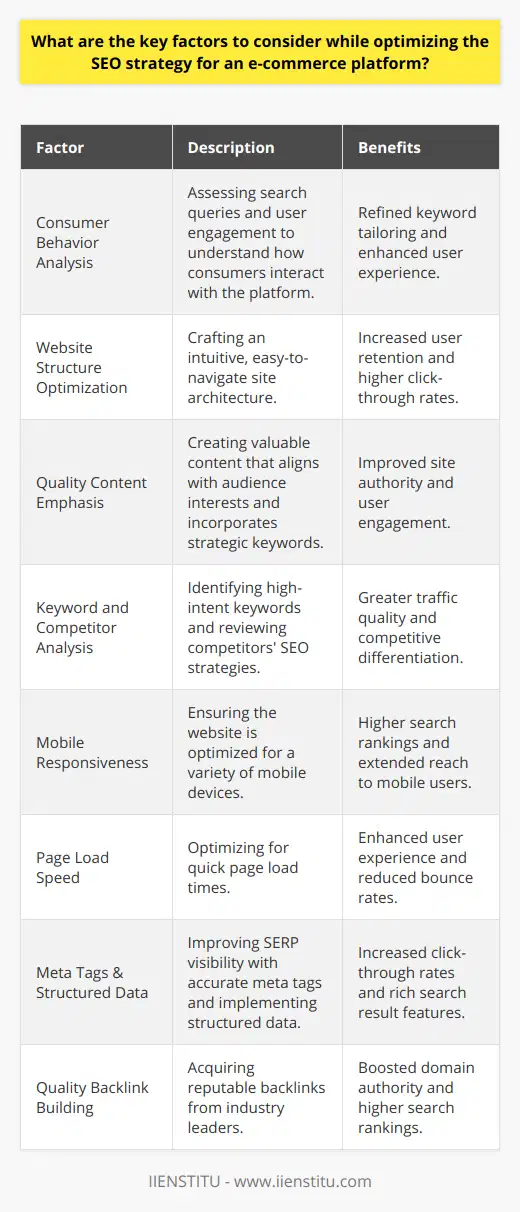
What are the specific challenges that ecommerce websites face when implementing SEO strategies?
Challenges in Implementing SEO Strategies for E-commerce Websites
Understanding User Intent
One challenge faced by e-commerce websites in implementing SEO strategies is understanding user intent while searching. Search intent varies among online shoppers, with some wanting to compare products, seek information about a specific item, or make a purchase. Determining the appropriate keywords to target, based on user intent, aids websites in attracting potential customers with relevant search queries.
Content Optimization
E-commerce sites must also focus on content optimization, ensuring that product descriptions and other on-page elements provide value to users and search engines. Unique and relevant product descriptions that answer customer queries are crucial, as duplicate content or thin, low-quality information can lead to poor search rankings.
Site Structure and Navigation
Creating a solid site structure with clear navigation aids both user experience and search engine crawlers. An intuitive, easy-to-navigate site structure allows customers to find their desired products efficiently while enabling search engine crawlers to index and understand the content effectively. However, e-commerce sites often struggle with numerous products, categories, and hierarchical structures, making it challenging to create well-organized navigation.
Technical SEO Issues
E-commerce websites face various technical challenges, including speed optimization, mobile responsiveness, and the handling of URL parameters. Slow page load times can negatively impact user experience and search engine rankings. With the growing importance of mobile browsing, ensuring mobile responsiveness plays a pivotal role in ranking well. Moreover, managing URL parameters can prove difficult, with faceted navigation, filters, and software-generated URLs leading to duplicate content or crawl budget issues.
Link Building
Link building is essential in increasing an e-commerce website's visibility and authority, but acquiring high-quality backlinks can be challenging. E-commerce websites must implement creative strategies that offer value to other websites and generate organic backlinks rather than relying solely on traditional outreach methods.
Internal Search Functionality
Lastly, improving the internal search functionality on e-commerce websites is vital in providing an optimal user experience. Effective search functionality enables users to find specific products quickly and increases the likelihood of conversion. Ensuring search functionality is optimized and aligned with SEO best practices is a unique challenge faced by e-commerce sites.
In conclusion, implementing SEO strategies for e-commerce websites is a complex process that involves understanding user intent, content optimization, site structure, addressing technical issues, link building, and internal search functionality. Overcoming these challenges enables e-commerce websites to improve their search engine rankings, grow organic traffic, and ultimately, drive sales.
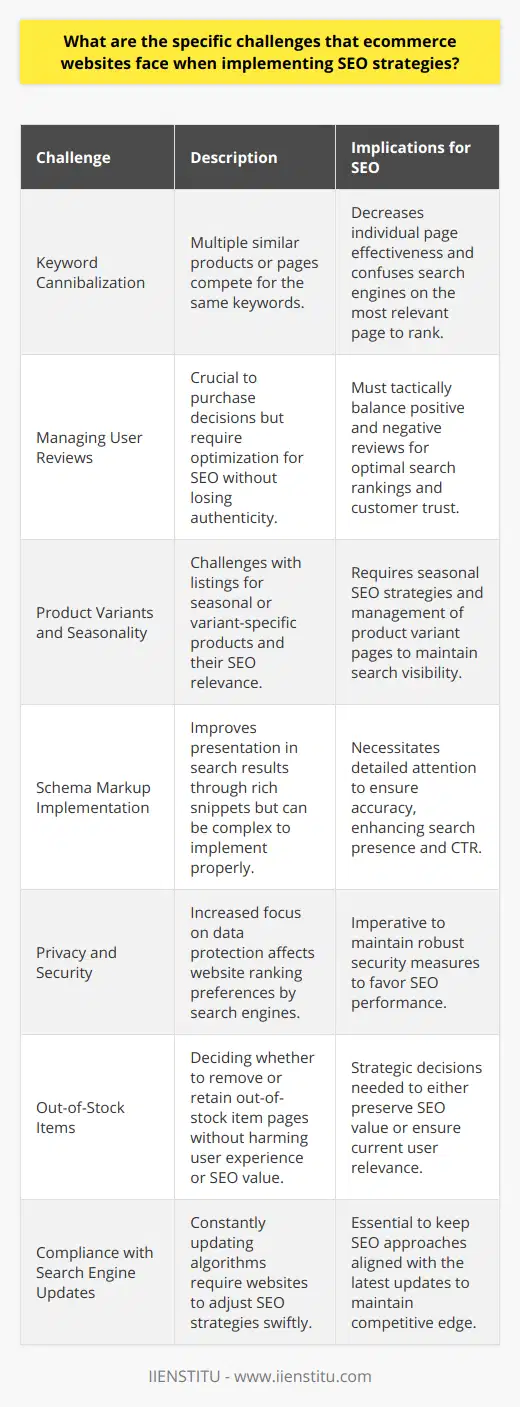
How can merchants assess the effectiveness of their SEO efforts on e-commerce platforms?
Measuring SEO Success on E-Commerce Platforms
Key Performance Indicators
Merchants can utilize key performance indicators (KPIs) to assess the effectiveness of their search engine optimization (SEO) efforts on e-commerce platforms. These KPIs are crucial to determine the success of SEO strategies and make data-driven decisions to improve the performance of e-commerce stores.
Organic Traffic
A primary KPI to monitor is organic traffic, which refers to the number of visitors who find a website through search engine results. A successful SEO campaign should result in increased organic traffic, indicating higher visibility and better search rankings.
Conversion Rate
Another vital KPI is the conversion rate, which is the proportion of visitors completing a desired action, such as purchasing a product or subscribing to a newsletter. Monitoring conversion rates is crucial for evaluating the profitability and effectiveness of SEO efforts.
Dwell Time and Bounce Rate
Additionally, dwell time and bounce rate are essential KPIs to consider. Dwell time measures how long visitors stay on a site, while bounce rate represents the percentage of users who leave after viewing a single page. High dwell time and low bounce rate suggest that an e-commerce site offers relevant and engaging content to users, thus reflecting successful SEO efforts.
Keyword Ranking
Assessing keyword rankings aids merchants in understanding their website's position in search engine results. Higher keyword rankings translate to improved visibility and increased organic traffic. Merchants must monitor ranking changes periodically to ensure that their SEO efforts continue to yield positive outcomes.
Backlinks
Moreover, backlinks - which are links from other websites to one's own site - play a vital role in strengthening SEO performance. Having a diverse and high-quality backlink profile indicates a website's authority and relevance, positively impacting search rankings. Merchants should regularly assess their backlink profiles to maintain and enhance their SEO efforts.
In conclusion, merchants can evaluate the effectiveness of their SEO initiatives on e-commerce platforms by monitoring KPIs such as organic traffic, conversion rate, dwell time, bounce rate, keyword ranking, and backlink profile. Continuously tracking these metrics enables merchants to optimize their strategies and achieve desired outcomes in their online stores.
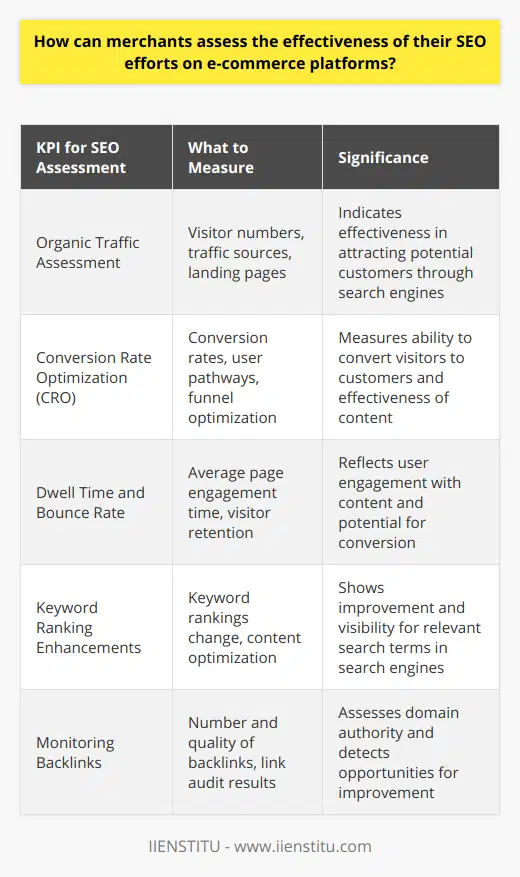
What on-page and off-page optimization techniques are recommended for achieving higher search rankings in the e-commerce sector?
On-Page Optimization Techniques
Keyword Optimization: In the e-commerce sector, achieving higher search rankings necessitates optimizing website content for relevant keywords. To identify the most effective keywords, thorough keyword research and competitor analysis are essential.
Meta Tags and Headings: Composing compelling meta titles and descriptions is crucial for improving click-through rates and attracting web traffic. Additionally, utilizing H1, H2, and H3 tags for headings and subheadings elevates website visibility and user engagement.
URL Structure: An SEO-friendly URL structure is integral for e-commerce websites to obtain higher search rankings. Incorporating relevant keywords and designing easily readable URLs contribute to enhanced search engine indexing.
Internal Linking: Employing an internal linking strategy strengthens site structure, reduces bounce rates, and facilitates easier navigation. Providing links to related products, blog posts, or guides enhances user experience and supports a comprehensive content strategy.
Off-Page Optimization Techniques
Link Building: In the e-commerce domain, securing high-quality backlinks from authoritative sites remains a primary goal. Collaborating with influencers, bloggers, and industry-specific websites attracts valuable links, thereby elevating search rankings.
Social Media Marketing: A strong presence on social media platforms, such as Facebook, Instagram, and Twitter, significantly benefits e-commerce brands. Strategic social media marketing bolsters website traffic, brand visibility, and organic search rankings.
User Reviews and Ratings: Encouraging customers to submit product reviews and ratings plays a pivotal role in organic search performance. Higher user-generated content volumes result in improved search rankings while fostering trust and credibility among potential buyers.
In conclusion, the e-commerce sector can achieve higher search rankings by effectively implementing on-page and off-page optimization techniques. Focusing on keyword optimization, meta tags, URL structure, internal linking, link building, social media marketing, and user reviews facilitates a balanced and efficient approach to search engine optimization.
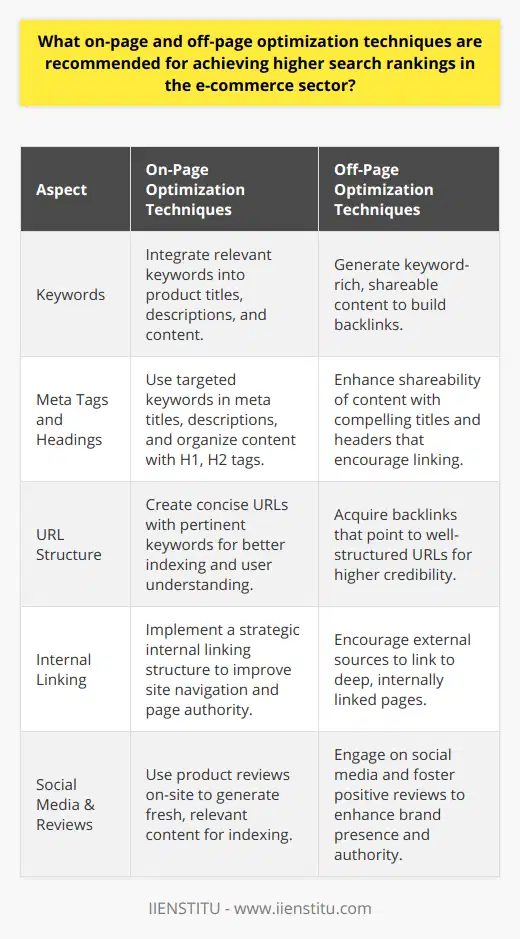
How does the integration of SEO features within an e-commerce platform contribute to improved user experience and search engine rankings?
Impact of SEO Integration on User Experience
The integration of Search Engine Optimization (SEO) features within an e-commerce platform significantly enhances user experience by providing relevant and personalized content to online shoppers. This relevance, in turn, increases the likelihood of customer satisfaction, engagement, and conversion to sales. By incorporating SEO techniques such as keyword research, website structure optimization, and high-quality content generation, e-commerce platforms can better understand and anticipate user needs and preferences, thereby improving the overall shopping experience.
Enhancement of Search Engine Rankings
In addition, the use of SEO tools and strategies within an e-commerce platform contributes to improved search engine rankings, increasing the visibility of the website to potential customers. Search engines like Google and Bing prioritize websites that offer valuable content and deliver an exceptional user experience. By optimizing the e-commerce platform for search engines, businesses can achieve higher search result rankings, which lead to increased organic traffic and opportunities for sales growth.
Role of Metadata and Descriptive Content
An essential aspect of the SEO integration process is the use of metadata and descriptive content to provide concise, accurate information about products and services on the e-commerce platform. Title tags, meta descriptions, and header tags should be optimized with relevant keywords that closely align with user search queries. This optimization allows search engines to identify and rank the website more effectively, ensuring that users find what they are looking for with minimal effort. Additionally, this approach fosters trust in the brand and encourages repeat visits to the site.
Encouraging User-generated Content
Another way that SEO features contribute to a better user experience and search engine rankings is by encouraging user-generated content such as reviews, testimonials, and social media shares. This type of content provides authentic, unbiased opinions about products and services, which can help potential customers make informed decisions. Furthermore, user-generated content can improve search rankings, as it increases the volume of keyword-rich content on the site and demonstrates its value to both search engines and users alike.
In conclusion, the integration of SEO features within an e-commerce platform not only contributes to an improved user experience but also helps businesses secure higher search engine rankings. A combination of personalized content, website structure optimization, and user-generated content provides customers with a seamless shopping environment and ultimately drives revenue growth for the e-commerce business.
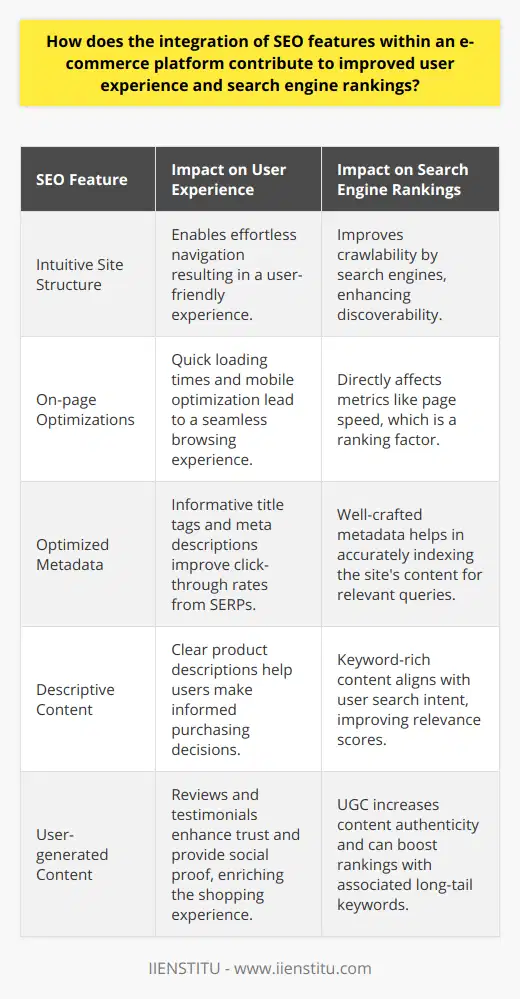
In the context of e-commerce, how do search engine algorithms evaluate and rank websites from a technical and content perspective?
Technical Factors in Search Engine Ranking
In the realm of e-commerce, search engine algorithms assess and rank websites through various technical factors. Site speed and responsiveness play a significant role, as faster websites provide a better user experience, which search engines reward with higher rankings. Additionally, secure websites utilizing HTTPS are preferentially ranked due to the increased protection they offer to users' data.
Mobile-friendliness is another important technical factor, with search engines prioritizing sites with responsive designs that accommodate various devices and screen sizes. Proper site structure, including the use of canonical tags and XML sitemaps, allows search engines to crawl and index pages efficiently, contributing to better rankings.
Content Evaluation and Ranking
Apart from technical aspects, search engine algorithms give immense importance to content quality in evaluating and ranking websites. Informative, relevant, and up-to-date content signals to search engines that a website is a valuable resource for users, which in turn improves its ranking. Originality of content is crucial, as search engines penalize plagiarized or duplicate content that offers little value to users in their search for information.
Keyword usage plays a critical role in content evaluation, with algorithms assessing the relevance of specific keywords to the overall theme of the website in question. Proper keyword density, harmoniously integrating target keywords within the content, enhances the chances of ranking higher for those terms. Furthermore, search algorithms consider semantic search, which focuses on understanding the intent and contextual meaning of words in a search query, to provide users with the most relevant results.
Backlinks and User Engagement
Finally, search engine algorithms evaluate websites in the context of e-commerce by considering the number and quality of backlinks. These algorithms view backlinks from reputable, high-authority sources as endorsements, leading to improved rankings. Additionally, user engagement metrics, such as click-through rates, time spent on site, and bounce rates, influence rankings, as they reflect the value and relevance of the content from the user's perspective.
In conclusion, search engine algorithms evaluate and rank e-commerce websites based on a combination of technical factors, content quality, backlinks, and user engagement. By optimizing these aspects, businesses can improve their online visibility, drive more organic traffic, and ultimately, increase their e-commerce sales.
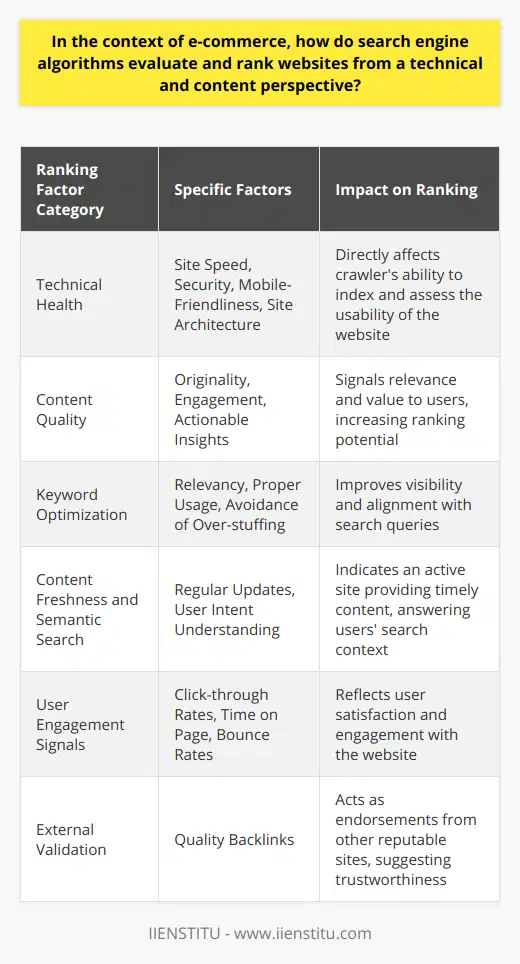
What are some common pitfalls that e-commerce businesses should avoid when optimizing their websites for search engines, and how can they address these issues for better overall performance?
Keyword Overuse and Misuse
One common pitfall e-commerce businesses face when optimizing their websites for search engines is the overuse or misuse of keywords. Excessive keyword repetition and irrelevant keywords can lead to search engine penalties, damaging a website's overall performance. To avoid this issue, use relevant and targeted keywords strategically and naturally throughout content, ensuring they make sense within the context.
Ignoring Site Structure and Navigation
Another common pitfall is neglecting site structure and navigation. Poorly organized websites with complex navigation can result in poor user experience and diminish search engine performance. To address this, create a clear and concise site structure that is easily navigable by both users and search engine crawlers, providing a seamless browsing experience.
Insufficient Content Quality
E-commerce businesses may also encounter challenges related to content quality. Low-quality content makes it difficult for search engines to understand the purpose of the website and rank it properly. To combat this issue, create informative, engaging, and well-written content that addresses user needs and positions the brand as an authority in its niche.
Lack of Mobile Optimization
Failing to optimize a website for mobile users can lead to a decline in search engine rankings and hinder overall performance. As more shoppers use mobile devices to access websites, it is crucial to implement responsive website design, ensuring a seamless experience for all users.
Slow Loading Speeds
Slow website loading speeds can result in decreased user engagement and lower search engine rankings. To improve speed, optimize images, utilize browser caching, and streamline code to create a faster-loading website that retains user interest and performs well in search engine results.
Ignoring Analytics and User Data
Lastly, failing to monitor analytics and user data can prevent businesses from making needed improvements to their websites. By consistently reviewing data from tools like Google Analytics, businesses can identify areas for improvement and implement changes to boost search engine performance.
In conclusion, common pitfalls faced by e-commerce businesses when optimizing for search engines include keyword overuse, poor site structure, and low-quality content. Avoiding these issues through targeted keyword use, improved site organization, and content enhancement, as well as addressing mobile optimization, website speed, and data analysis, can significantly improve overall website performance in search engine rankings.
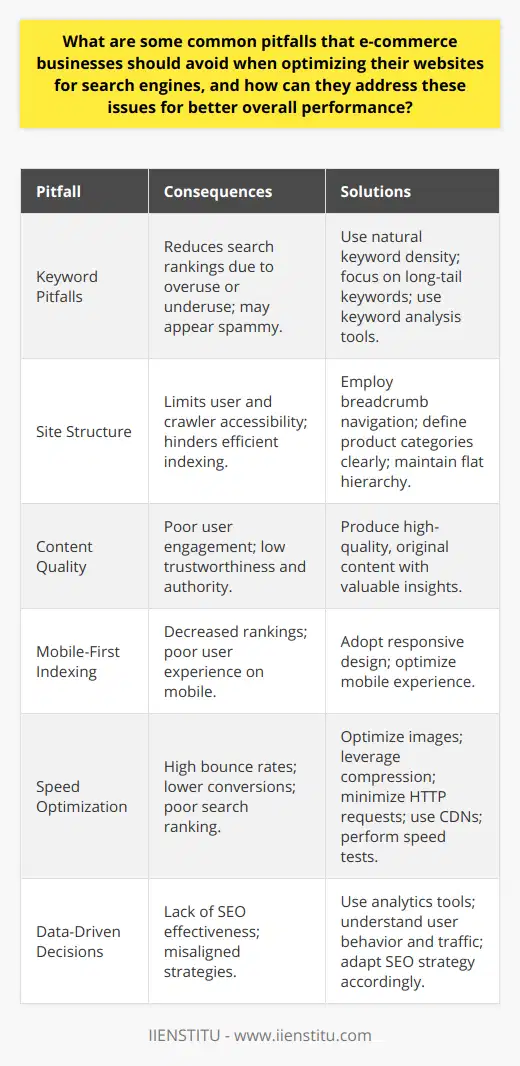
How does SEO impact the user experience and conversion rates in e-commerce?
User Experience and SEO
An integral component of e-commerce success is the incorporation of search engine optimization (SEO) strategies that enhance user experience (UX) on a website. Investing in SEO practices not only increases the visibility of an e-commerce platform on search engines like Google, but it also plays a significant role in shaping the overall user experience. As a result, customers are more likely to engage with the website, leading to increased conversion rates – a critical factor for e-commerce profitability.
Navigation and Site Structure
Optimizing a website's content and ensuring smooth navigation can contribute to enhanced user satisfaction. By implementing clear, concise, and easily accessible menus and categories, customers can efficiently locate and explore their desired products or services. Moreover, with proper site structure, search engines can effortlessly crawl and index the website. Thus, ensuring that potential customers can easily find and engage with the platform, consequently leading to an increase in conversion rates.
Page Load Speed and Mobile Responsiveness
Another essential aspect of SEO is optimizing a website's load speed and ensuring its adaptability to mobile devices. A sluggish website can deter potential buyers, increasing the site's bounce rate and negatively impacting the conversion rate. Simultaneously, with the growing reliance on mobile devices for online shopping, the absence of a mobile-friendly website compromises the user experience. Therefore, optimizing a website's load speed and adaptability to both desktop and mobile platforms is crucial for improving overall user satisfaction and conversion rates.
Relevant and Engaging Content
Implementing SEO also involves creating relevant, valuable, and engaging content for the target audience. This practice significantly impacts the user experience and conversion rates in e-commerce, as trustworthy and compelling content attracts more customers and encourages them to interact with the platform. Additionally, well-written and unique product descriptions, instructional articles, and appealing visual elements contribute to better rankings on search engine result pages (SERPs), further benefiting the e-commerce platform's success.
In conclusion, SEO serves as a vital component in shaping the user experience and conversion rates within e-commerce. By optimizing various aspects such as navigation, site structure, speed, mobile responsiveness, and content, businesses can enhance their platform's user experience. As a result, satisfied customers are more likely to engage with the platform, leading to increased conversion rates – ultimately contributing to the overall success and profitability of an e-commerce business.
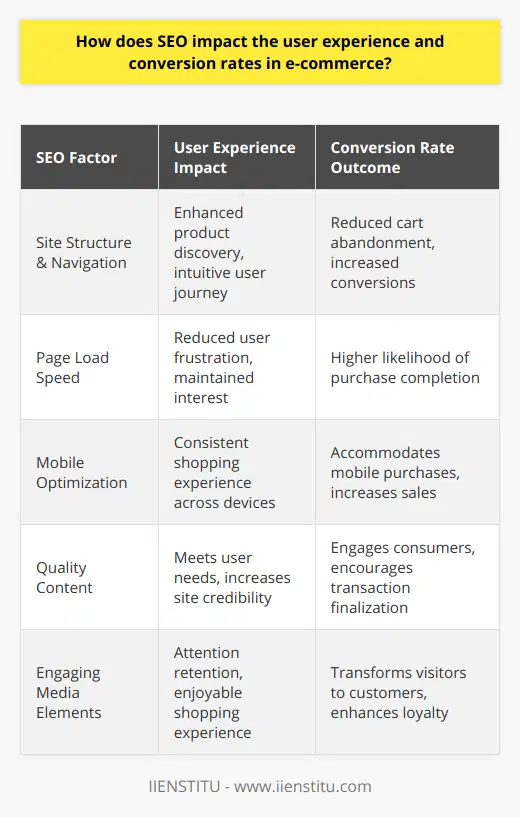
What role do keyword research and selection play in creating an effective e-commerce SEO strategy?
Role of Keyword Research and Selection
In the realm of e-commerce, a successful SEO strategy begins with keyword research and selection. Keyword research primarily aims at identifying search terms that potential customers use while searching for products and services online. These search terms, or keywords, can then be strategically incorporated into digital content, making the online presence of a business more visible to potential buyers. Therefore, keyword research and selection are fundamental components of an effective e-commerce SEO strategy.
Relevance and Search Volume
Understanding the relevance and search volume of keywords is crucial for creating an SEO approach that yields results. Relevance pertains to the degree to which a keyword accurately reflects the products or services offered by an e-commerce business. A high degree of relevance ensures that the targeted keywords will attract potential customers actively looking for the products or services being provided. Additionally, search volume indicates the frequency with which a keyword is used by online searchers. A higher search volume implies a greater likelihood of users encountering the e-commerce website while searching.
Long-tail Keywords and Competitiveness
One effective strategy for e-commerce businesses is to target long-tail keywords. Long-tail keywords refer to specific search phrases that are typically composed of three or more words. These more detailed queries often result in higher conversion rates because they represent users with a stronger intent to purchase. Moreover, focusing on long-tail keywords reduces competition, as these phrases tend to be less sought after by other businesses.
Investing in Keyword Research Tools
To successfully conduct keyword research, e-commerce businesses must invest in dedicated tools. Several platforms provide extensive keyword suggestions, analyze the competition for specific keywords, and track performance over time. Utilizing these tools can significantly improve the effectiveness of an e-commerce SEO strategy by ensuring informed keyword selection.
Ongoing Analysis and Adaptation
Lastly, it is vital to continually monitor and adjust keyword selection in response to changing trends and user behaviour. Regularly updating and adapting the keywords on an e-commerce site can maintain visibility and relevance, leading to sustained success.
In conclusion, keyword research and selection are essential to creating an effective e-commerce SEO strategy. By understanding the relevance and search volume, targeting long-tail keywords, investing in research tools, and continually analyzing performance, businesses can optimize their online presence and bolster their revenue-generating potential.
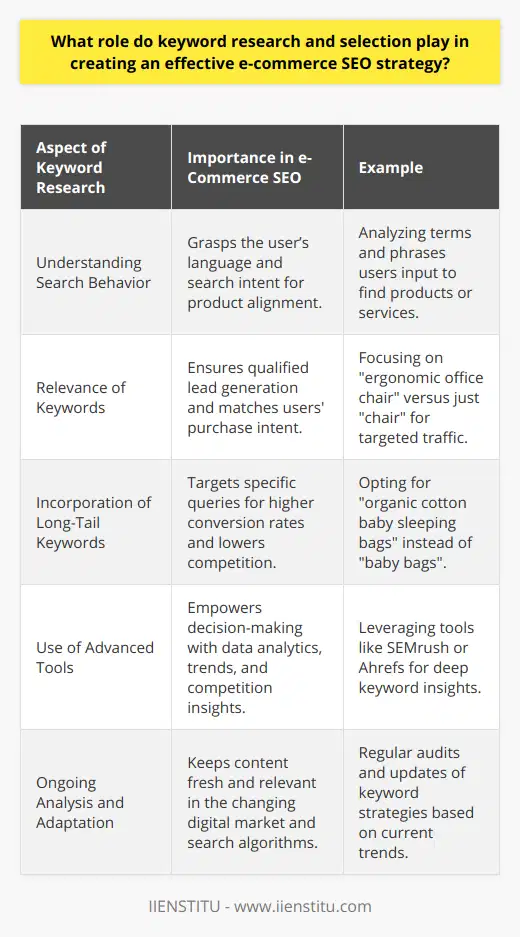
How can the use of structured data and schema markup enhance the search engine visibility of e-commerce websites?
**Enhancing Search Engine Visibility**
The utilization of structured data and schema markup is crucial for enhancing the search engine visibility of e-commerce websites. Structured data refers to information formatted using specific, universally recognized models, making it easier for search engines to read and understand the content. Schema markup is a standardized vocabulary that webmasters use to annotate their web content with structured data, enabling search engines to display more accurate and detailed information in search results.
**Improving Search Results**
Integrating structured data and schema markup in e-commerce websites leads to an improved appearance of search results, as it enables search engines to offer additional and relevant information about the products and services. This additional information, known as rich snippets, may include product ratings, prices, and availability. Rich snippets contribute to increased click-through rates, as users are more likely to select results that provide valuable and easily digestible information at a glance.
**Achieving Better Indexing**
Employing structured data and schema markup also assists search engines in better indexing and understanding an e-commerce website's content. By making the content more accessible, search engines can more accurately categorize the website and improve its ranking in search results. Consequently, websites that use structured data increase their visibility and have a higher likelihood of attracting potential customers.
**Supporting Voice Search**
The demand for voice search has grown with the rise of smart speakers and virtual assistants. Structured data and schema markup enable e-commerce websites to better communicate with voice search devices, optimizing the content for voice-specific queries. As a result, this implementation contributes to increased visibility and engagement via voice searches, further expanding the potential customer base.
**Staying Competitive**
In conclusion, the integration of structured data and schema markup in e-commerce websites proves to be essential in enhancing search engine visibility. By presenting rich snippets, improving indexing, and supporting voice search, websites greatly improve their online presence and stay competitive in the rapidly evolving digital marketplace. Considering the impact on user experience and search engine optimization, it is of paramount importance for e-commerce businesses to adopt structured data and schema markup to ensure success in today's data-driven environment.
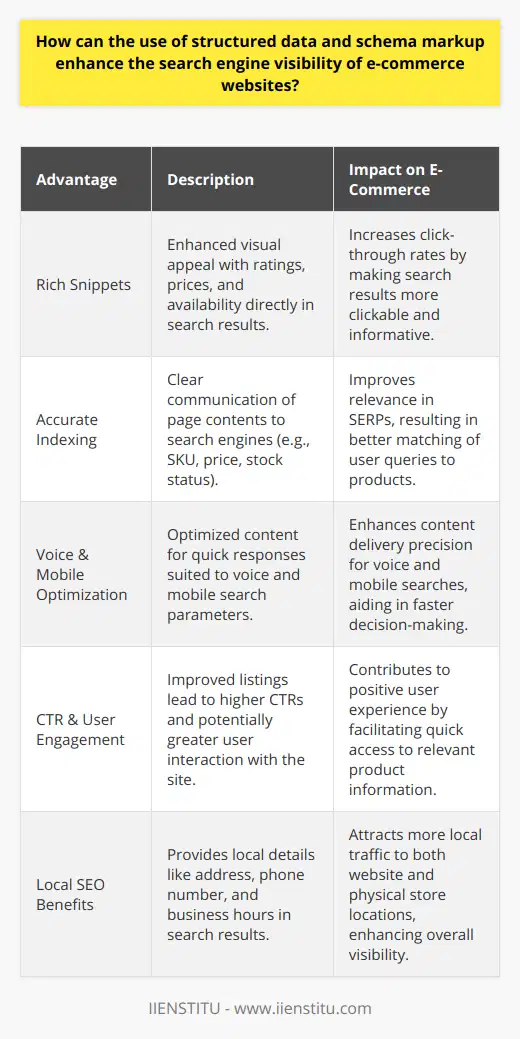
How is ecommerce SEO different from traditional SEO practices in terms of targeting and optimizing product listings?
Differences in Targeting and Optimization Approaches
Ecommerce SEO differs significantly from traditional SEO practices, concerning targeting and optimizing product listings. Two primary factors distinguish these two approaches: the use of structured data and a focus on user experience.
Structured Data Utilization
Traditional SEO methods rely on keyword targeting, metadata, and content optimization to increase visibility and rankings in search engine results. In contrast, ecommerce SEO emphasizes the implementation of structured data, such as schema markup and product feeds, that provide search engines with detailed information about product listings. This structured data allows ecommerce websites to have enriched search results, showcasing product attributes such as price, availability, and customer ratings. These enhanced results can significantly improve click-through rates and conversion rates for businesses.
User Experience Focus
While both ecommerce and traditional SEO aim to enhance user experience, ecommerce SEO is specifically designed to optimize product listings to meet user requirements and facilitate seamless transactions. This approach incorporates elements such as image optimization, clear calls-to-action, and easy navigation to guide potential customers through the purchase process. Additionally, ecommerce SEO employs strategies such as optimizing product descriptions, enhancing site load speed, and ensuring mobile-friendliness to maximize user engagement and generate successful sales.
Integration of Reviews and Ratings
Another aspect that differentiates ecommerce SEO from traditional SEO is the integration and optimization of customer reviews and ratings. Ecommerce websites often prioritize showcasing reviews and ratings on product listings, as these features are crucial in influencing the purchase decision-making process. Optimizing and managing this user-generated content allows for potential buyers to find relevant, trustworthy information, resulting in a higher likelihood of conversion.
Competition for Position Zero
Lastly, ecommerce SEO practices focus on securing the coveted 'Position Zero' on search engine results pages—a primary objective for ecommerce businesses. Position Zero consists of featured snippets, knowledge panels, and other search engine results that appear above the typical organic listings. Obtaining this position increases visibility, attracting potential customers and providing a crucial competitive edge for ecommerce websites.
In conclusion, ecommerce SEO diverges from traditional SEO practices through differences in targeting and optimization approaches, with a focus on structured data, user experience, reviews and rating integration, and competition for Position Zero. These distinctions help online retailers offer enhanced, consumer-driven product listings, resulting in increased click-through rates, engagement, and successful transactions.
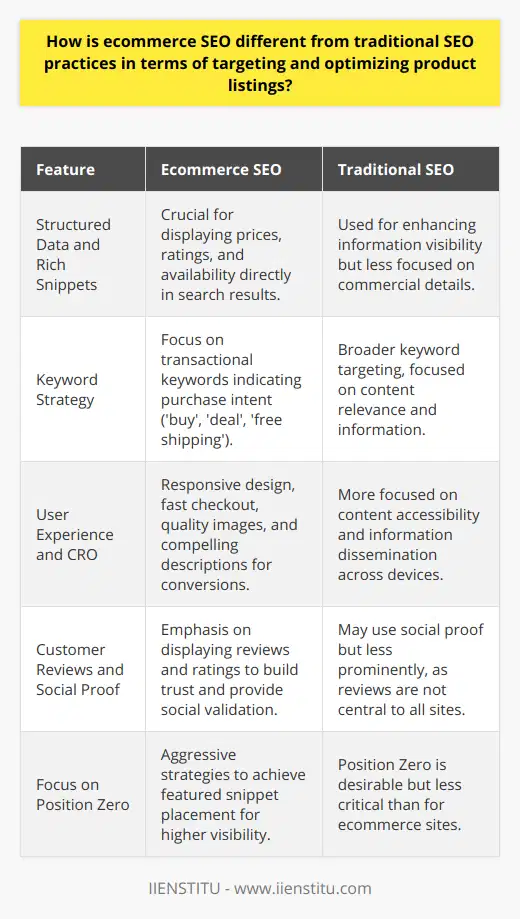
What are the primary technical aspects to consider when implementing SEO features on e-commerce websites to achieve optimal search engine performance?
Keyword Optimization
One of the primary technical aspects to consider when implementing SEO features on e-commerce websites is keyword optimization. Proper keyword research, selection, and placement strategically throughout the website significantly influence search engine performance.
Site Structure
Another essential aspect is the site structure, which ensures a good user experience and efficient crawling of search engines. The creation of a site hierarchy with a logical organization and the inclusion of internal links to relevant products or pages can enhance SEO efforts.
Mobile Responsiveness
To achieve optimal search engine performance, implementing a mobile-responsive design is crucial. Search engines prioritize websites with designs that adapt to various screen sizes and load efficiently on different devices. Neglecting this aspect may negatively affect the website's ranking.
URL Structure
An SEO-friendly URL structure is necessary for improved search engine performance on e-commerce websites. The use of descriptive, concise URLs with relevant keywords will make it easier for both users and search engines to understand the purpose of the web page.
Meta Tags and Descriptions
Incorporating relevant meta tags and descriptions is another technical aspect to address for successful SEO implementation. Meta tags, such as title tags and header tags, should include the main keyword, while meta descriptions should be informative and enticing to encourage users to click.
Page Load Speed
Enhancing page load speed is essential for improved search engine performance, as slow-loading web pages result in high bounce rates. Compressing images, minifying HTML, CSS, and JavaScript files, and using browser caching can significantly improve load times.
Rich Snippets and Structured Data
Using rich snippets and structured data markup helps search engines understand the content of the pages better, resulting in better ranking and visibility in search results. This can be achieved by incorporating schema markup that provides context to the product or service information on the website.
Backlink Strategy
Lastly, establishing a backlink strategy is vital for successful SEO on e-commerce websites. Acquiring high-quality, relevant backlinks from authoritative sites not only increases the website's credibility but also enhances its search engine ranking and visibility.

Does SEO for ecommerce businesses require a distinct approach to content creation and optimization when compared to non-e-commerce websites?
Distinct Approach for E-commerce SEO
Indeed, SEO for e-commerce businesses necessitates a distinct approach to content creation and optimization compared to non-e-commerce websites. The primary difference lies in the objectives and strategies employed for driving organic traffic to satisfy specific business goals.
Keywords and User Intent
E-commerce SEO demands a deeper understanding of keywords and user intent. In contrast to non-e-commerce websites, where keywords may be informational or educational, e-commerce website keywords are often transactional and geared towards driving sales. It is essential to incorporate long-tail keywords and product-related terms that resonate with the target audience's search queries.
On-Page Optimization Strategies
E-commerce websites need effective on-page optimization strategies to enhance their search engine ranking and user experience. These include incorporating SEO-rich product titles, crafting engaging and informative product descriptions, and optimizing image alt tags and URL structure. Additionally, using schema and structured data for creating rich snippets enhances search visibility and can yield a competitive advantage.
Link Building and Content Marketing
While both e-commerce and non-e-commerce websites benefit from building high-quality, authoritative backlinks, e-commerce businesses must prioritize link-building efforts on product category and individual product pages. E-commerce link-building strategies usually involve influencer collaborations, blogger reviews, and outreach initiatives. Content marketing activities, such as publishing guest posts and maintaining a high-quality blog, reinforce these efforts by providing valuable information and promoting products to potential customers.
Site Structure and Navigation
An SEO-friendly site structure is critical for e-commerce websites, necessitating seamless navigation, intuitive categorical organization, and a responsive design. Ensuring that all pages are indexed, implementing breadcrumbs, and maintaining a flat website architecture improve users' browsing experience and impact search rankings positively. Mobile optimization, along with fast-loading pages, further contribute to better user experience and search engine visibility.
Technical SEO and Security
E-commerce websites demand special attention to technical SEO aspects, such as canonicalization, proper redirection, and reducing duplicate content. Additionally, ensuring a secure environment for transactions, employing HTTPS, and focusing on website security measures are imperative for instilling trust and bolstering conversion rates.
In conclusion, e-commerce businesses must adopt a distinct approach to SEO and content creation to achieve their goals effectively. Tailored techniques for keyword research, on-page optimization, link-building, site structure, and technical SEO must all work harmoniously to drive organic traffic and sales conversions.
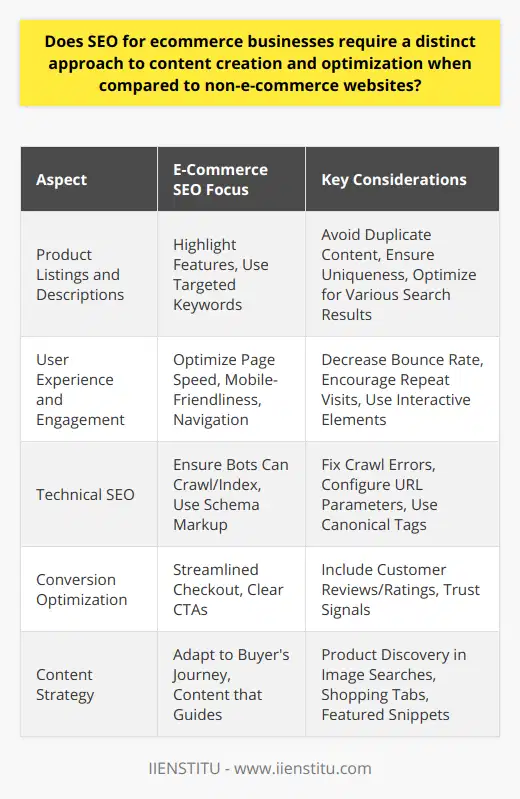
What is the most important thing when doing SEO for an ecommerce site?
Understanding Ecommerce SEO
In the realm of ecommerce, arguably the most critical aspect of Search Engine Optimization (SEO) strategy lies in comprehensive keyword research. Keywords fundamentally dictate the trajectory of SEO, guiding search engines to specific content and informing the structuring of that content within a site.
Keyword Research Essentials
Keywords represent the central questions, topics, and interests of potential customers. Understanding the search patterns customers employ in finding products or services helps in tailoring content on the website. Strategically chosen keywords attract target audiences and increase visibility. To achieve this, consider relatable, realistic, and relevant words customers may search.
Importance of Competitive Analysis
Conducting competitive analysis for keywords also plays a pivotal role. It implies studying competitors to better understand which keywords they rank for. Insights from this analysis can help in refining keyword optimization strategies. This often leads to discovering new keywords which may initially have been overlooked.
On-Page SEO Elements
Furthermore, the profound use of these keywords within on-page SEO elements like meta descriptions, alt text, and page titles is indispensable. These on-page signals help search engines understand the content of the site, which affects the site's visibility on search engine results pages or SERPs.
Off-Page SEO Factors
Likewise, off-page SEO such as backlinks and social signals enhance an ecommerce site's SEO. These factors show search engines that the site is trustworthy and reputable, which boots its ranking.
Monitoring SEO Performance
Finally, monitoring the SEO performance frequently is a must. This involves using tools like Google Analytics to assess the effectiveness of keyword usage. The garnered data enables regular optimization of the SEO strategy based on the site's performance.
In conclusion, undertaking thorough keyword research, combined with strategic on-page and off-page SEO deployment, rests at the heart of effective ecommerce SEO. Yet, it's crucial to continually monitor and readjust this strategy in line with performance metrics and evolving customer search behaviours.
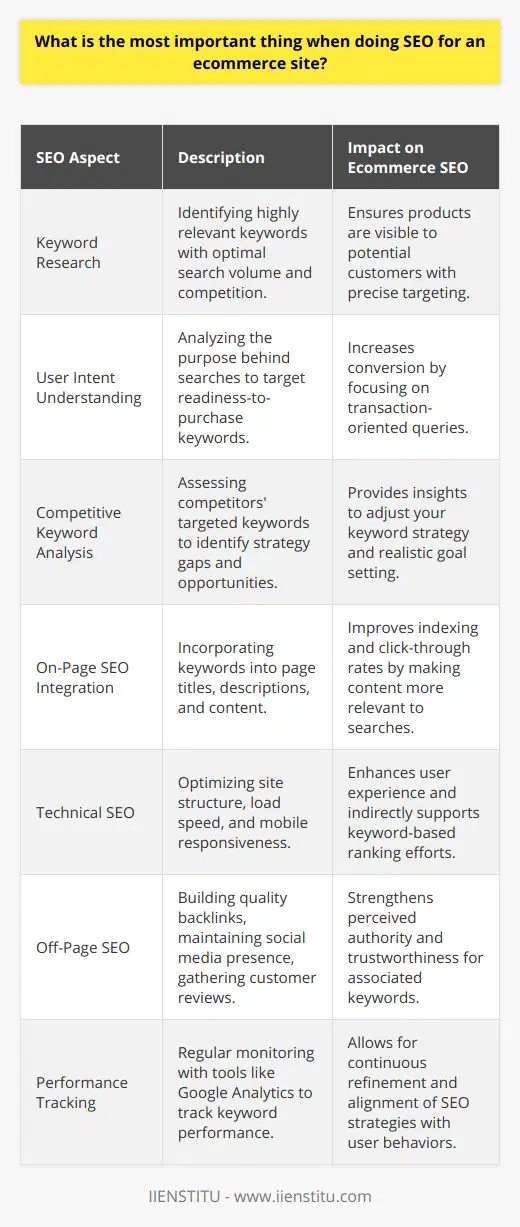
Is SEO worth it for ecommerce businesses considering the competition and the need for paid advertising?
Significance of SEO for Ecommerce Businesses
Many ecommerce businesses grapple with the question of whether SEO proves worthy considering fierce competition and required spending on paid advertising. Research points to a resounding yes.
Impact of SEO
Firstly, SEO boosts a website's visibility organically, making it more likely for consumers to stumble upon your online shop. This equates to more clicks, potentially more sales, and ultimately generating increased revenue. Unlike paid advertising, this type of visibility is long-lasting and does not disappear when the advertising budget is exhausted.
SEO and Customer Trust
SEO further builds consumer trust and credibility. Websites appearing on the first page of search engine results are typically viewed as more reliable by consumers. This positive association can enhance the reputation of your ecommerce business.
The Role of Keywords
Knowledgeable usage of keywords, a core aspect of SEO, can target your desired audience effectively. This means your business has a better chance of reaching potential customers who are actively searching for your products, thus increasing conversion rates.
SEO vs Paid Advertising
Paid advertising may provide a quick visibility boost, but SEO is more sustainable in the long run. It is a cost-effective strategy that, while requiring upfront effort, can yield substantial returns in the end. In light of these observations, ecommerce businesses would be remiss not to incorporate SEO into their online marketing strategies.
Conclusion
Therefore, the question is not whether to use SEO, it is how effectively you can utilize it. SEO might seem daunting due to competition and a need for honed expertise, but its long-term benefits for ecommerce businesses are manifold. As long as there are search engines and consumers depend on them to seek produc+ts, SEO will continue to be key for the success of any ecommerce business.
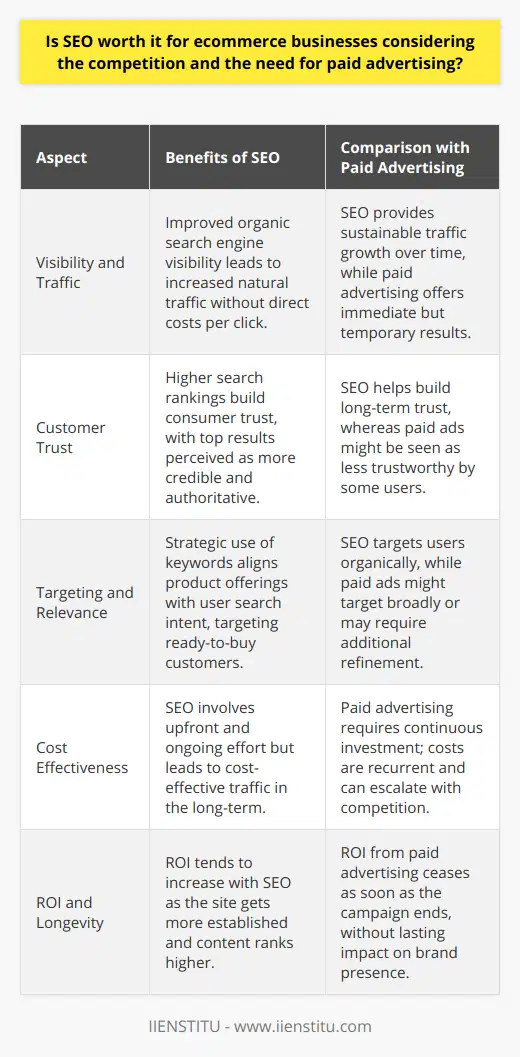
How do SEO features in e-commerce platforms support the overall growth and visibility of online stores in search engine results pages?
Effective Keyword Usage
SEO features in e-commerce platforms enhance website visibility by leveraging keywords. Through strategic keyword placements, these platforms can optimize content to rank higher in search engine results pages (SERPs). This optimization drives web traffic and ultimately leads to increased sales.
Influence of Meta Descriptions
Moreover, meta descriptions play a substantial role in influencing click-through rates (CTRs). These descriptions provide concise previews of a webpage’s content. If well-crafted, meta descriptions can compel users to click and visit the website, thus boosting its SERP ranking.
Benefits of SEO-friendly URLs
SEO-friendly URLs also contribute to online store visibility. These URLs, which include relevant keywords, allow search engines to comprehend the content of the page. As such, they increase the likelihood of achieving a prominent position in organic search listings.
Impact of Mobile Optimization
E-commerce platforms that prioritize mobile optimization also rank higher in SERPs. Given the number of people using mobile devices for online shopping, platforms that offer seamless mobile experiences gain competitive advantages. Search engines, recognizing this trend, favor mobile-optimized sites.
Importance of Social Sharing
Social sharing capabilities in e-commerce platforms further influence visibility and growth. When users share products or pages on their social platforms, this generates backlinks and directs more traffic to the website. Search engines consider these links as endorsements, thereby improving the website’s authority and position in SERPs.
Significance of Quality Content
Lastly, the provision for quality, engaging content significantly impacts a website’s SERP ranking. Good content magnetizes audience attention and encourages them to stay on the site. For search engines, this lower bounce rate signals a quality website, influencing a higher ranking.
Thus, through various features, SEO capability in e-commerce platforms facilitates increased visibility and growth of online stores on SERPs. It's evident that to stay competitive, online store owners must harness the power of SEO.
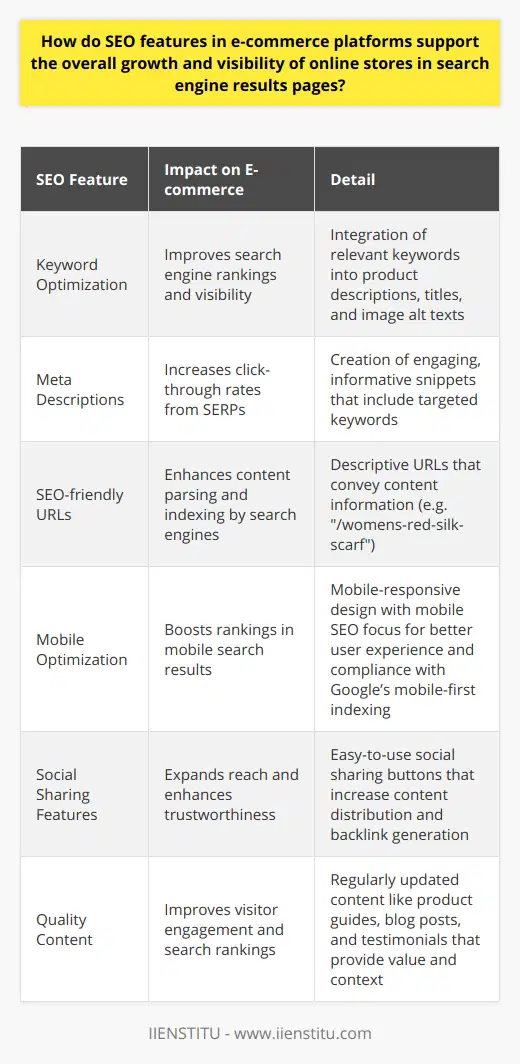
What are important SEO items for an e-commerce store?
Keyword Optimization
The backbone of any successful SEO strategy is keyword optimization. E-commerce stores should conduct thorough keyword research to understand which terms potential customers use when searching for their products or services. These keywords should feature across the website, including in product descriptions, meta tags, and image alt text to improve the store's visibility in search engine results.
User Experience
Search engines reward websites that offer excellent user experiences. Factors such as website loading speed, mobile-friendliness, easy navigation, and secure checkout process play vital roles in enhancing user experience and boosting SEO. E-commerce stores must, therefore, invest in these areas to rank higher on search engine results pages.
Content Marketing
Google and other search engines prioritize high-quality, relevant content. An e-commerce store should include a blog section where they post helpful, engaging content related to their products or industry. This helps attract organic traffic and backlinks, thereby improving the site's SEO.
Technical SEO
Technical SEO elements, including site architecture, XML sitemaps, and structured data, also impact an e-commerce store's SEO. These elements help search engines crawl and index the website more effectively. They require careful implementation and ongoing upkeep to ensure optimal performance.
Backlinks
Inbound links from credible and relevant sources boost an e-commerce site's authority in the eyes of search engines. Techniques such as guest blogging, influencer outreach, and PR can assist in securing these valuable backlinks. The higher the number of quality backlinks, the better the site's chances of ranking high on search results.
Social Media Integration
Finally, integrating social media with e-commerce can also influence SEO. Search engines consider social signals, such as likes, shares, and comments, as indirect ranking factors. Hence, an e-commerce store can improve its SEO by maintaining a robust presence on popular social media platforms.
In conclusion, the performance of an e-commerce store's SEO strategy depends on various elements, all of which warrant equal and continuous attention.

How do e-commerce websites differ from other websites as far as SEO is concerned?
Special SEO Techniques for E-commerce Websites
E-commerce websites differ from other sites in SEO application due to their distinct structure and objectives. These websites aim to influence users to make purchases. Therefore, the SEO strategies deployed must not only rank high in search engine results pages (SERPs) but also engage and convert visitors effectively.
Keyword Targeting and SEO Merchandising
Understanding and meeting user intent is crucial. Marketers must incorporate specific product and brand names into the website content and meta tags. This approach, known as SEO merchandising, is specific to e-commerce websites. It helps improve visibility for product-specific searches.
Product Descriptions and User Experience
Unique, high-quality product descriptions optimize SEO results and enrich the user experience. Websites containing duplicate descriptions may suffer penalties, lowering SERP ranking. Also, E-commerce websites require efficient navigation and site architecture, improving user experience and lowering bounce rates.
Importance of User Reviews
User reviews significantly influence SEO for e-commerce websites. Having product reviews on the site increase the amount and uniqueness of content. Reviews also help in naturally incorporating long-tail keywords, which usually have a higher conversion rate.
SEO for Mobile Users
Considering the proliferation of mobile shopping, optimizing e-commerce websites for mobile users has become crucial. Improving website loading speed, using an easily navigable layout, and offering simplified shopping carts contribute to enhanced mobile SEO.
Utilizing Rich Snippets
In addition to standard SEO practices, e-commerce websites often utilize rich snippets. These provide advanced information such as product ratings, which enhances the site's visibility on SERPs.
In conclusion, e-commerce websites require a more detailed SEO strategy. The focus extends beyond ranking high on SERPs to delivering an engaging user experience that drives conversions. These unique requirements necessitate special SEO techniques to ensure optimal performance.
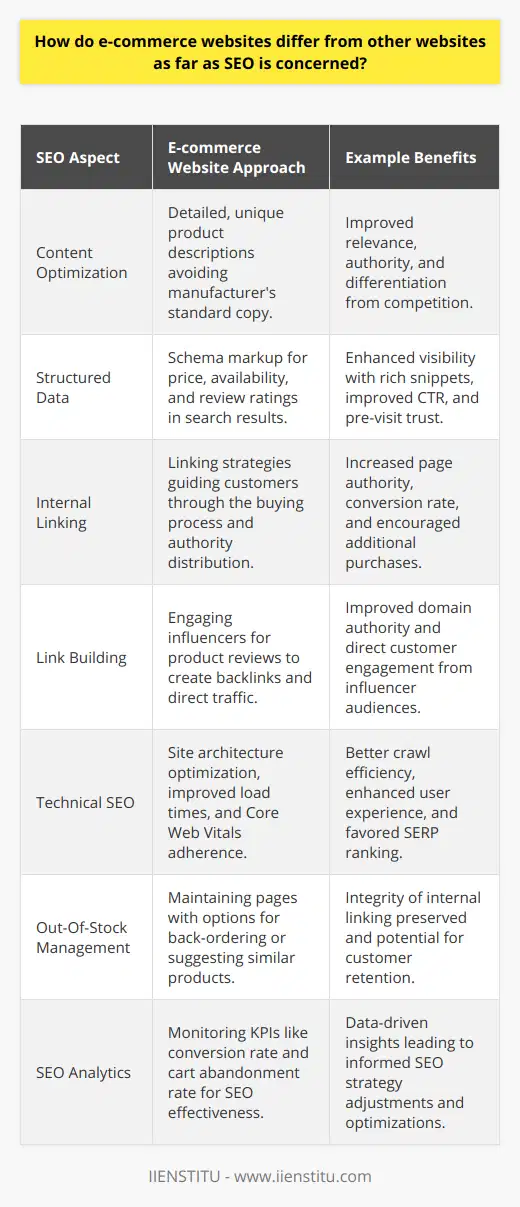
What is SEO in e-commerce?
Understanding SEO in E-Commerce
SEO, or Search Engine Optimization, forms a critical aspect of digital marketing that aids e-commerce businesses to increase their online visibility. It involves optimizing website content, including product descriptions, metadata, and images, to improve search engine rankings and attract organic traffic.
SEO Components
The main components of SEO include keywords, content, and backlinks. Keywords entail relevant terms that people commonly search for, and incorporating these into website content can help e-commerce sites rank higher on search engine result pages (SERPs). A comprehensive content strategy fuels SEO by providing valuable information, branding, and interaction with potential customers. Backlinks denote inbound links to the website from other sites, which are crucial for establishing online authority and relevance.
SEO Benefits
The benefits of SEO for e-commerce are broad and impressive. Primely, the right SEO strategies can exponentially boost web traffic and online visibility, thus increasing opportunities for sales and conversions. It also enhances user experience making the website more navigable, clear, and user-friendly. Further, SEO elevates brand credibility, as users often trust websites that appear on the first page of SERPs more.
Conclusion
In summary, SEO is a quintessential marketing strategy for e-commerce that drives organic traffic, enhances user experience, and boosts brand credibility through the strategic use of keywords, content, and backlinks. Ignoring the importance of SEO in your eCommerce strategy may result in missed opportunities for growth and success.
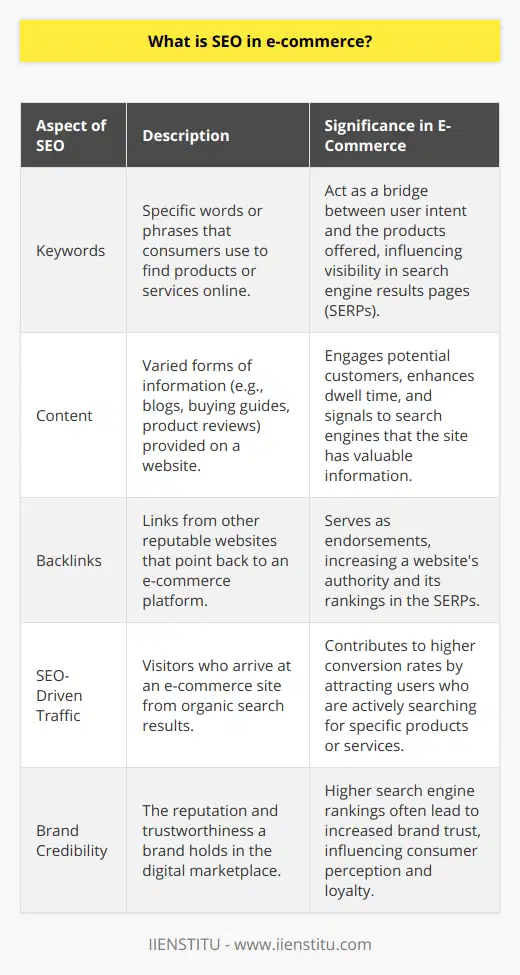
What are the main distinctions between SEO strategies employed in e-commerce websites compared to non-e-commerce sites?
SEO Fundamentals in E-commerce
E-commerce sites generally use extensive product-focused optimization, unlike non-e-commerce sites. The focus of SEO strategy in e-commerce is towards product descriptions, categories, and internal search engine features. On the other hand, non-e-commerce sites typically focus more on providing information through blog posts or articles. Therefore, their SEO strategy revolves more around topic clusters and keywords within the body text and the structure of the site.
Keyword Use in E-commerce and Non-E-commerce SEO
E-commerce websites focus heavily on targeted, product-related keywords. They optimize product titles, descriptions, and images tags with commercially viable keywords to attract possible customers. Non-e-commerce sites, however, typically aim to engage and inform visitors. So, they optimize their headings, subheadings, and the content for informational keywords.
Consideration of Customer Journey
In e-commerce SEO, strategies often include creating content that targets customers at all stages of the buying cycle - awareness, consideration, and decision. The goal is to guide customers towards a purchase. However, non-e-commerce SEO strategies focus on imparting knowledge. They tend to concentrate on visitor engagement, retaining visitors through insightful content, and encouraging return visits.
User Experience Optimization
User experience plays a major role in the SEO of e-commerce sites due to a direct correlation with conversion rates. Strategies often include site speed optimization, mobile friendliness, and simple navigation. On the contrary, non-e-commerce sites focus more on the readability and relevance of content to offer a smooth user experience.
Conversion Rate Emphasis
Finally, the focus of SEO in e-commerce is often on increasing conversion rates. Tactics include optimizing product pages, using compelling call-to-actions, and streamlining the checkout process. However, the success of SEO in non-e-commerce sites is often measured by the amount of quality traffic and engagement metrics like time-on-site and bounce rate.
In summary, though both use SEO, e-commerce and non-e-commerce websites place emphasis on different elements. The former leans more towards product promotion and conversion, while the latter favors information delivery and engagement.
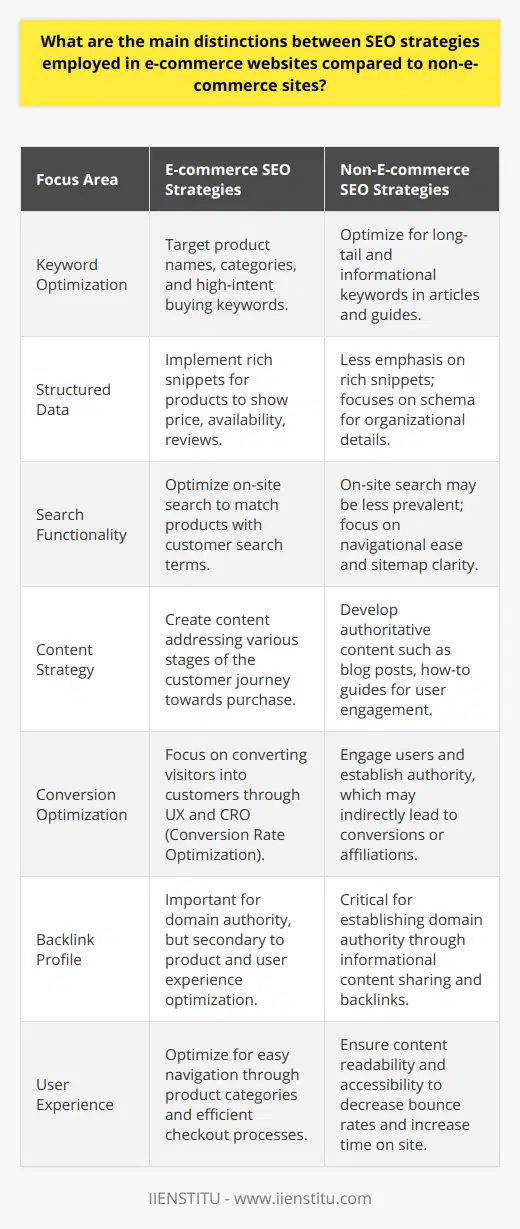
How does utilizing relevant SEO techniques in an e-commerce context influence both organic traffic and conversion rates?
Effect on Organic Traffic
SEO techniques play a central part in amplifying the visibility of e-commerce platforms. Their function lies in optimizing particular keywords associated with the business's products or services. When a company integrates these relevant keywords in their content, search engines, such as Google, can identify and boost their ranking.
This elevation in rank grants such e-commerce platforms an augmented visibility among users, likely resulting in an increase in organic traffic. Organic traffic refers to the online users reaching the platform through unpaid search engine results.
Influence on Conversion Rates
Importantly, SEO strategies do not merely increase the quantity of website visits, but also focus on the quality of the visitors. By targeting specific keywords sought by prospective customers, companies effectively attract an audience with a higher possibility of transaction.
These 'high-quality' visitors have the potential to convert from mere visitors of the site into actual customers. A well-executed SEO strategy can therefore lead to a higher conversion rate. Conversion rate denotes the proportion of visitors who perform the intended action (e.g. making a purchase) on the site.
SEO Optimization Strategies
Adopting an innovative SEO strategy includes on-page and off-page optimization. On-page optimization involves techniques such as keyword integration and meta-description optimization. Off-page optimization includes actions such as back-linking and improving site authority. These strategies increase relevance and visibility, leading to enhanced organic traffic and conversion rates.
In summary, using relevant SEO strategies in an e-commerce context significantly influences both organic traffic and conversion rates. It enhances a platform's visibility, attracts a substantial, 'high-quality' audience, and boosts the likelihood of transactions.
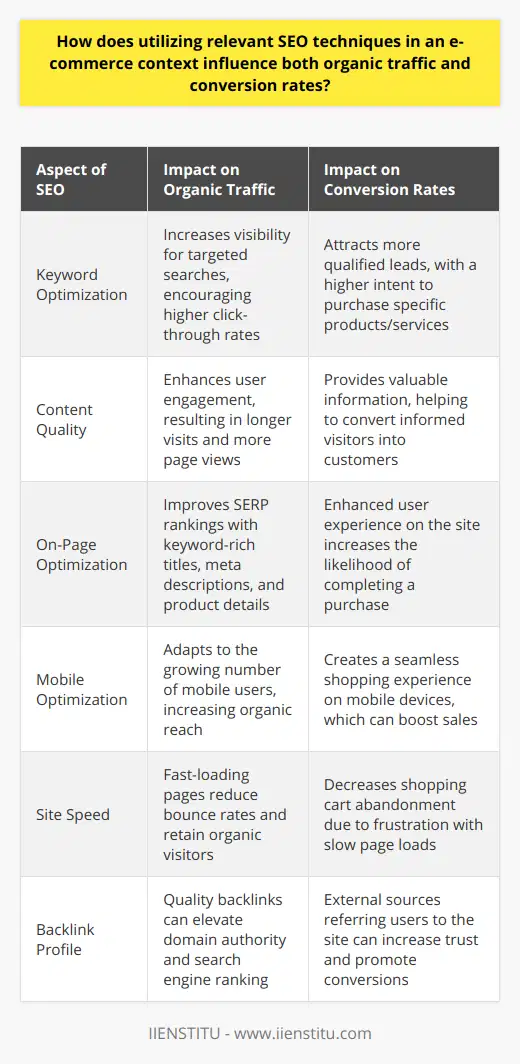
What specific on-site and off-site optimization practices are essential for enhancing the search engine performance of e-commerce platforms?
On-Site Optimization Techniques
Key on-site optimization techniques hold substantial influence over the search engine performance of e-commerce platforms. A crucial practice involves keyword optimization. Fine-tuning the website content with relevant keywords and phrases can significantly boost the site's search engine rankings. Likewise, URL structuring is a critical component of on-site SEO. URLs should clearly indicate the content of the website page.
Meta tags, which provide a description of the page's content, play an imperative role in search engine rankings. High-loading speed of a site can enhance user experience. An intimate correlation exists between an e-commerce platform's search engine ranking and its loading speed. Structuring the site in a navigational manner and using heading tags correctly are vital as well.
Off-Site Optimization Practices
Several off-site optimization strategies also accentuate the performance of e-commerce platforms on search engines. The practice of link building, establishing external links pointing back to the website, can immensely improve search engine rankings. It is paramount that these links originate from reputable and relevant sources.
Developing a robust social media presence has become a necessity in today's digital market. Consistent posting and interacting with customers can boost visibility and drive more traffic to the e-commerce site. Additionally, guest blogging and influencer marketing strategies can extend the site's reach, enhance its reputation and increase its ranking.
A significant off-site tactic is earning online reviews. Positive reviews can enhance trust, drive traffic, and improve search engine performance. In its essence, the concerted application of both on-site and off-site optimization practices can substantially enhance the search engine performance of e-commerce platforms.



